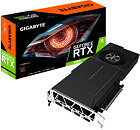Saturday, September 19th 2020

GIGABYTE Unveils RTX 3090 TURBO: For When You Absolutely Need Lateral Blowers for 350W GPUs
Perhaps the most unique GeForce RTX 3090 offerings from GIGABYTE has to be the Turbo Edition. Possibly its most cost-effective card based on the $1,500 GPU, the Turbo Edition features a classic lateral-blower based cooling solution that guides all its air through an aluminium channel-type heatsink, and out of the rear bracket, with none of it exhausted into the case. This is a bold choice for a cooler given the feisty 350 W typical board power for the RTX 3090. The card is exactly 2 slots thick, and just 26.6 cm long, making it possibly the shortest air-cooled RTX 3090. It's a little over 11 cm tall (standard full-height). An interesting design choice by GIGABYTE is to locate the card's two 8-pin PCIe power connectors at the tail end of the card. GIGABYTE didn't reveal whether the card features factory-overclocked speeds, but we expect it to stick to reference speeds. Display outputs include two each of HDMI 2.1 and DisplayPort 1.4a connectors.





56 Comments on GIGABYTE Unveils RTX 3090 TURBO: For When You Absolutely Need Lateral Blowers for 350W GPUs
Useful if you want to slap few of those into rack server mount in a render farm. I wouldn't buy it for sure for consumer kind of build. Considering how noisy was for example Pascal 1080Ti FE this ^ card draws 100W more of nominal power while retaining same inefficient cooling. I was rendering on 3x 1080Ti before watercooling them when blocks became available. I tell you I could hear that jet factory through few, really solid (in some places reinforced) concrete (old, old building) walls. Night rendering was a no-no.
If nothing else, waterblock compatibility lists usually paint a pretty clear picture of what reference is.
Gamers: HUNTER WEAPON!
If the air in your case is warm because of the CPU, you're sucking in warmer-than-cold air and blowing hot air. It's more efficient for an AIO to simply wick away the heat.
I'm surprised they haven't designed cases that suck in cold air, channel it right to the card and then out the back, but that's because cases aren't adapted to GPU design.
I'd like to see some case maker address that issue.
AIO is the best in my opinion.
A 240mm AIO on my 9900K + an AIO on the GPU just works better.